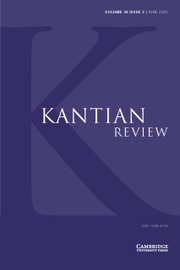Article contents
Comment on Gorner
Published online by Cambridge University Press: 27 September 2011
Extract
In his incisive and provocative analysis, ‘The place of punishment in Kant's Rechtslehre’, Paul Gorner discusses many aspects of Kant's position. I concentrate on his main contention:
Kant's justification of judicial punishment simply does not fit the account of right he gives in the Rechtslehre. According to this account the only justification for coercion is that it constitutes a ‘hindering of a hindrance’ to freedom. But there is no way in which this requires punishment to be retributive.
- Type
- Articles
- Information
- Copyright
- Copyright © Kantian Review 2000
References
Notes
1 Kantian Review, 4 (2000), 138–147.Google Scholar
2 Ibid., 138. See too 145.
3 Ibid., 142.
4 Ibid.
5 Ibid., 144. Gorner, is commenting on Metaphysics of Morals (MS), 6:231.Google Scholar
6 Ibid., 145.
7 Ibid.
8 MS 6:231, in Mary Gregor's trans. (Cambridge: Cambridge University Press, 1991), quoted by Gorner, 144.
9 ‘The place of punishment in Kant's Rechtslehre’, 141. Incidentally, I think Kant's argument is sound at this point, and Gorner is mistaken to try to correct it. In setting the penalty for a crime, Kant requires the legislature and the court to take account of the kind of factor Gorner mentions, such as the fear and insecurity produced among the citizens, as Kant's handling of the case of stealing shows (MS 6: 333). But setting a penalty which reflects the various kinds of damage done, to the victim and more widely, is completely different from trying to ‘undo’ the damage or to deter others. The latter are extraneous goals and if taking account of them increases the penalty, the penalty is to that extent necessarily ‘too severe’ (and unjust).
10 For a suggestive analysis in this direction, see Hill, Thomas E Jr., ‘Punishment, conscience, and moral worth’, The Southern Journal of Philosophy, 36, supplement (1997), 51–71.CrossRefGoogle Scholar
11 I am grateful to Susan Mendus and Matt Matravers for their comments.
- 2
- Cited by


